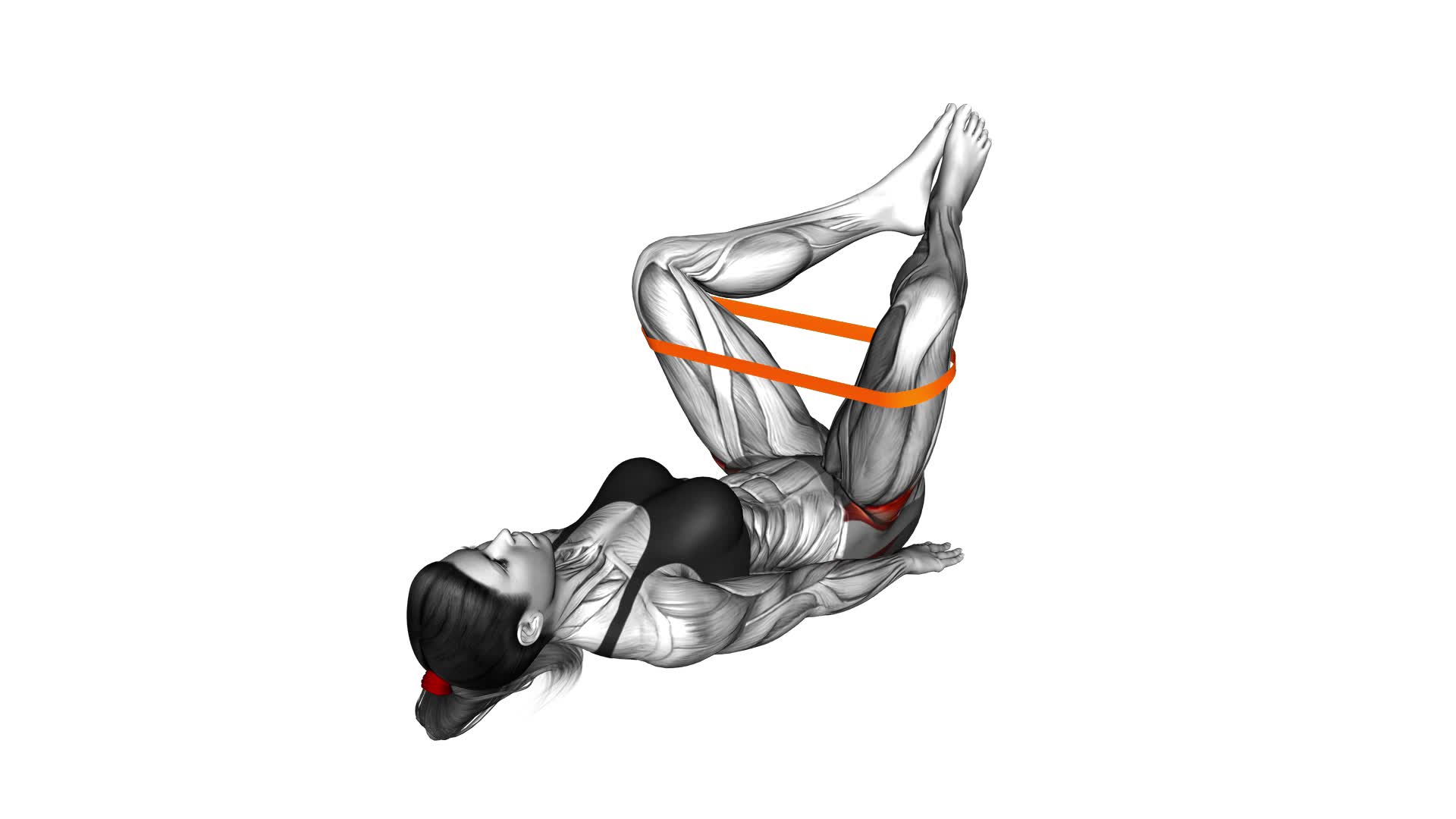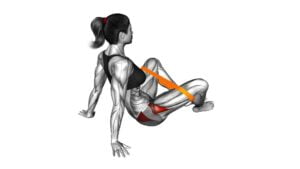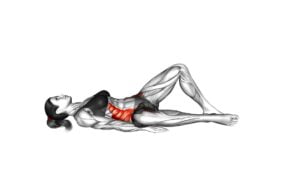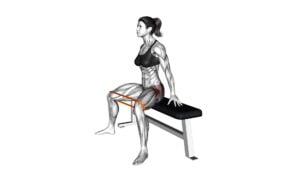Resistance Band Lying Bent Knee Hip Abduction (female) – Video Exercise Guide & Tips

Are you looking to tone and strengthen your hip muscles? Look no further than resistance band lying bent knee hip abduction.
Watch This Exercise Video
This exercise targets your glutes and outer thighs, helping you achieve a sculpted lower body.
In this video exercise guide, you'll learn the proper form and technique, variations and progressions, and common mistakes to avoid.
Plus, we'll share tips on how to incorporate this exercise into your workout routine for maximum results.
Let's get started!
Key Takeaways
- Resistance band lying bent knee hip abduction targets glutes and outer thighs.
- It engages muscles in the hips, including glutes, hip flexors, and abductors.
- Using a resistance band adds extra challenge and promotes muscle growth.
- This exercise improves balance, stability, and hip mobility while preventing hip and knee injuries.
Benefits of Resistance Band Lying Bent Knee Hip Abduction
To fully understand the benefits of resistance band lying bent knee hip abduction, it's important that you recognize how this exercise can effectively strengthen and tone your hip muscles. By engaging in this exercise, you're specifically targeting the muscles in your hips, including the glutes, hip flexors, and abductors. The resistance band adds an extra challenge, making your muscles work harder and promoting muscle growth.
One of the key benefits of resistance band lying bent knee hip abduction is the strengthening of your hip muscles. As you perform this exercise, the resistance band provides resistance against your movements, forcing your muscles to contract and work against it. This constant resistance helps to strengthen your hip muscles, making them more resilient and able to handle daily activities with ease.
Additionally, this exercise can also improve your balance and stability. By strengthening the muscles in your hips, you're enhancing the support and stability of your body. This can be particularly beneficial for athletes or individuals who engage in activities that require balance, such as yoga or dancing.
In the subsequent section, we'll discuss the proper form and technique for resistance band lying bent knee hip abduction, ensuring that you get the most out of this exercise and minimize the risk of injury.
Proper Form and Technique for Resistance Band Lying Bent Knee Hip Abduction
To perform resistance band lying bent knee hip abduction correctly, you'll need a resistance band and a mat or comfortable surface to lie on.
Begin by lying on your side with your knees bent and your feet together. Place the resistance band just above your knees and secure it in place.
Keep your bottom leg straight and your top leg bent at a 90-degree angle. Engage your core muscles and slowly lift your top knee away from your bottom knee, using the resistance band for added resistance. Make sure to keep your hips stacked and your body in a straight line. Avoid letting your top hip roll forward or backward during the movement.
Common errors to watch out for include using too much tension on the resistance band, which can strain your muscles, and failing to engage your core, which can lead to poor form.
If you find this exercise too challenging, you can modify it by using a lighter resistance band or by performing the movement without a band until you build up strength.
Remember to always listen to your body and stop if you experience any pain or discomfort.
Variations and Progressions for Resistance Band Lying Bent Knee Hip Abduction
As you progress in your resistance band lying bent knee hip abduction routine, you can explore different variations and progressions to challenge your muscles even further. Here are three variations and modifications you can try:
- Increased Resistance: To make the exercise more challenging, you can use a resistance band with higher resistance or double up on the bands. This will add more tension to your muscles and require them to work harder.
- Single-Leg Abduction: Instead of performing the exercise with both legs, you can focus on one leg at a time. This won't only increase the difficulty but also help improve balance and stability.
- Tempo Variation: Varying the tempo of the exercise can also provide a new challenge. Try performing the abduction movement slowly and with control, then speed up the movement for a more explosive contraction. This will engage different muscle fibers and enhance overall muscle development.
By incorporating these variations and modifications into your routine, you can continue to progress and keep your workouts challenging.
Now, let's move on to the next section about common mistakes to avoid during resistance band lying bent knee hip abduction.
Common Mistakes to Avoid During Resistance Band Lying Bent Knee Hip Abduction
To ensure proper form and maximize the effectiveness of the resistance band lying bent knee hip abduction exercise, it's important to be aware of common mistakes to avoid. By avoiding these mistakes, you can reduce the risk of injuries and get the most out of your workout.
One common mistake is using too much resistance. It's important to start with a resistance level that allows you to perform the exercise with proper form. Using too much resistance can put excessive strain on your muscles and joints, increasing the risk of injury.
Another mistake to avoid is allowing your hips to rotate or lift off the ground during the exercise. This can result in improper activation of the targeted muscles and decrease the effectiveness of the exercise. To prevent this, focus on keeping your hips stable and maintaining a neutral spine throughout the movement.
Lastly, make sure to avoid compensating by using other muscles to perform the exercise. This can happen when you're fatigued or using too much resistance. If you find yourself compensating, try using a lighter resistance band or modifying the exercise to target the specific muscles you're trying to work.
Tips for Incorporating Resistance Band Lying Bent Knee Hip Abduction Into Your Workout Routine
To effectively incorporate resistance band lying bent knee hip abduction into your workout routine, focus on proper form and gradually increase the resistance level as you progress. This exercise provides numerous benefits, including strengthening the hip muscles, improving hip stability, and enhancing overall lower body strength.
Here are three tips to help you incorporate this exercise into your routine:
- Choose the right resistance band: Select a band that provides enough resistance to challenge your muscles without causing pain or discomfort. Start with a lighter resistance band and gradually increase the tension as you become stronger.
- Warm up before starting: Prior to performing resistance band lying bent knee hip abduction, warm up your body with some light cardio exercises, such as jogging or jumping jacks. This will help increase blood flow to the muscles and prepare them for the workout.
- Focus on proper form: Maintain a neutral spine throughout the exercise and engage your core muscles. Keep your knees bent and feet flat on the ground. Slowly lift your leg out to the side, using the resistance band to provide tension. Pause for a moment at the top, then slowly lower your leg back down. Repeat on the other side.
Frequently Asked Questions
How Long Does It Take to See Results From Resistance Band Lying Bent Knee Hip Abduction?
To see results from resistance band lying bent knee hip abduction, it's important to stay consistent and gradually increase the intensity of your workouts.
Start with a resistance band that challenges you but still allows proper form. As you get stronger, you can progress by using a higher resistance band or increasing the number of repetitions.
Avoid common mistakes like using momentum or lifting your leg too high.
With dedication and proper technique, you should start seeing improvements in your hip strength and stability over time.
Can Resistance Band Lying Bent Knee Hip Abduction Help With Postpartum Recovery?
Resistance band lying bent knee hip abduction is a great exercise for postpartum recovery. It targets the muscles in your hips and glutes, helping to strengthen and tone them.
Additionally, this exercise can also help with postpartum fitness by engaging your pelvic floor muscles.
Are There Any Specific Warm-Up Exercises Recommended Before Performing Resistance Band Lying Bent Knee Hip Abduction?
Before performing resistance band lying bent knee hip abduction, it's important to do specific warm-up exercises. These exercises help prepare your muscles for the workout and reduce the risk of injury.
They can include dynamic stretches, such as leg swings and hip circles, to increase blood flow and mobility in the hip area.
Incorporating warm-up exercises into your routine will enhance the benefits of resistance band exercises, allowing you to get the most out of your workout.
Can Resistance Band Lying Bent Knee Hip Abduction Help With Improving Balance and Stability?
Resistance band lying bent knee hip abduction is a great exercise to improve balance and stability. By targeting the muscles in your hips and thighs, this movement helps strengthen your core and develop better control over your body.
Athletes can particularly benefit from this exercise as it enhances their overall performance and helps prevent injuries. Incorporating resistance band lying bent knee hip abduction into your routine won't only improve your balance and stability, but also boost your athletic abilities.
Is It Safe to Perform Resistance Band Lying Bent Knee Hip Abduction if I Have a Knee or Hip Injury?
If you have a knee or hip injury, it's important to take precautions when performing resistance band lying bent knee hip abduction exercises. Make sure to consult with a healthcare professional to determine if this exercise is safe for you. They can provide modifications and recommendations to accommodate your injury.
Beginners should start with lighter resistance bands and focus on proper form to avoid further strain. Always listen to your body and stop if you experience any pain or discomfort.
Conclusion
Incorporating resistance band lying bent knee hip abduction into your workout routine can provide numerous benefits. This exercise specifically targets and strengthens the hip abductor muscles, which play a crucial role in stabilizing the lower body. By adding this exercise to your routine, you can improve your overall lower body stability.
To maximize the effectiveness of this exercise, it is important to maintain proper form and technique. This includes keeping your core engaged, maintaining a neutral spine, and aligning your knees with your hips. Avoid common mistakes such as using excessive tension on the resistance band or letting your knees collapse inward.
One of the advantages of this exercise is the ability to vary the resistance band tension and progress over time. You can start with a lighter band and gradually increase the tension as your muscles get stronger. Additionally, you can incorporate variations such as using a looped band or performing the exercise with straight legs to challenge your muscles in different ways.
By consistently incorporating resistance band lying bent knee hip abduction into your routine, you can build stronger hip abductor muscles and improve your overall lower body stability. With time and effort, you will see progress and enjoy the benefits of a more stable lower body.

Author
Years ago, the spark of my life’s passion ignited in my mind the moment I stepped into the local gym for the first time. The inaugural bead of perspiration, the initial endeavor, the very first surge of endorphins, and a sense of pride that washed over me post-workout marked the beginning of my deep-seated interest in strength sports, fitness, and sports nutrition. This very curiosity blossomed rapidly into a profound fascination, propelling me to earn a Master’s degree in Physical Education from the Academy of Physical Education in Krakow, followed by a Sports Manager diploma from the Jagiellonian University. My journey of growth led me to gain more specialized qualifications, such as being a certified personal trainer with a focus on sports dietetics, a lifeguard, and an instructor for wellness and corrective gymnastics. Theoretical knowledge paired seamlessly with practical experience, reinforcing my belief that the transformation of individuals under my guidance was also a reflection of my personal growth. This belief holds true even today. Each day, I strive to push the boundaries and explore new realms. These realms gently elevate me to greater heights. The unique combination of passion for my field and the continuous quest for growth fuels my drive to break new ground.







